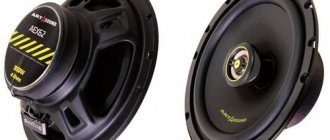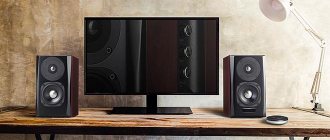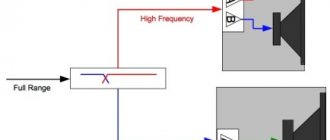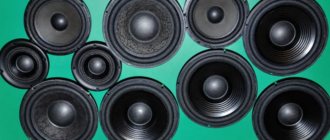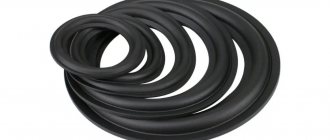The design of the speaker speaker as a source of sound propagation is a very interesting point. On the one hand, very soon its traditional design in its current form will celebrate its centenary. On the other hand, changes in the materials used and options for the proximity of elements are an inexhaustible source of engineering ideas. And, as a result, a brighter, more perfect sound, which step by step brings audiophiles closer to His Majesty Perfect Sound.
And if you want to better understand the reasons for the delight of the authors of certain reviews of new speaker systems, we strongly recommend that you understand what a speaker speaker consists of and what significance each of its components has.
Speaker structure: clear and accessible
The basis of any speaker is a frame, also often called a “basket” or “spider”. All other structural elements are placed in the frame.
In the rear part of the frame there is an annular gap, which is formed by a magnetic core (core) and a ring magnet. The minimum distance between the core and the ring magnet, also shaped like a ring, ensures maximum powerful magnetic field.
The voice coil is located in the magnetic gap. It is formed by winding metal wire around a cylindrical thin-walled frame, which is coated with a layer of insulating varnish. When exposed to a magnetic field, which occurs when alternating current passes, the voice coil moves back and forth in accordance with the shape of the reproduced sound vibrations.
The voice coil frame is attached to the diffuser. The latter is a movable element of the speaker design that directly reproduces sound. To allow vibrations, the diffuser has suspensions - thin washers with concentric convexities. Made of flexible material, the diffuser suspensions allow its movement along the axis of symmetry. The diffuser moves back and forth under the influence of a voice coil, through which alternating current is supplied through torque-free wires.
The front part of the diffuser is covered with a dust cap. This safety structural element performs both a protective and decorative function.
Thus, having analyzed the structure of the speaker speaker, you can move on to a more detailed consideration of the specifics of each of the elements. The various technologies and materials used to create them determine the enormous variety of such high-tech products.
New in blogs
A speaker, or “loudspeaker,” is a device for converting electrical signals into acoustic signals and radiating them into the surrounding space. Having disassembled a music center or any sound speaker (for example, a subwoofer) of a home theater, you will definitely find inside one or more speakers that differ in size, weight, shape... Usually the speaker has a round (less often oval) metal frame, to which a paper diffuser with a centering washer and a coil (solenoid). On the other side, a permanent round magnet with a core is glued to the frame. There is free space between the magnet and the core in which the coil can move freely.
On Wikipedia you can read that the word “speaker” is all wrong, which, it turns out, is what a loudspeaker is often called in common parlance and jargon. They even express some fanciful thoughts about the origin of the word “speaker.” In fact, everything is very simple. A loudspeaker in English is called “A dynamic loudspeaker” - hence the “speaker”. Similarly, during my childhood, any transistor radio was called a “transistor”...
Photo 5 shows two regular 8-ohm speakers from old computers.
| Photo 5. A regular 8-Ohm computer speaker (left) and a similar one with a cut-out diffuser. The remains of the diffuser show a sleeve glued to it, on which a winding is wound (on the right). |
How does a speaker work?
You can read something like the following in books. The magnet and the core create a uniform constant magnetic field in the space between them. When an electric current is passed through the coil, an Ampere force arises in it under the influence of this constant magnetic field, F = BI l , and the coil begins to move, dragging the diffuser along with it. A diffuser oscillating at a sound frequency creates “rarefaction and compression waves” in the surrounding air.
Since an alternating voltage (audio frequencies, ~ 20...20,000 Hz) is supplied to the speaker coil from the output stage of the power amplifier, accordingly, the direction of the current in the coil changes with the same frequency. The amplitude of the coil oscillations is proportional to the amplitude of the change in the magnitude of the Ampere force, which means it is proportional to the amplitude of the change in the current strength in the coil. In short, the greater the amplitude of the current in the coil, the louder the sound.
This is roughly what happens in reality. There are just a few clarifications.
As we learned from Oersted's experiment (see Chapter 2), an electric current passing through a conductor induces a magnetic field. If the current is constant, then the magnetic field created by this current is also constant. If the current changes in magnitude and direction, then the magnetic field created by this current will also be variable and will also change in magnitude and direction.
This can be checked in a simple way - attach the speaker coil (or the solenoid made in the last chapter) to the compass and change the polarity of the battery (see photo 6). The compass needle will begin to rotate, turning toward the coil (solenoid) with either the red end or the white end. The oscillation frequency of the needle will be equal to the pole switching frequency. You can apply an alternating current of low sound (20 Hz), or even better, infrasonic frequency (1...5 Hz) to the speaker winding - the compass needle will begin to tremble with the frequency of changes in the direction of the current. In this way we create an alternating magnetic field.
Such an alternating magnetic field is widely used by humanity. For example, to perform mechanical work - in electric motors. And also in the speakers.
| Photo 6. As you can see, the computer speaker coil also confirms Oersted's discovery and Ampere's law. |
So, the physical meaning of the dynamics is as follows. The alternating created by the coil , “tied” to the light coil, interacting with the constant magnetic field (radiation) of the permanent magnet of the speaker, “tied” to the massive permanent magnet, creates a mechanical force that causes the diffuser to oscillate. The diffuser, pushing gas molecules with its mass that elastically interact with each other, locally changes the pressure in the surrounding air space. These wave-like changes in the pressure of a gaseous medium, with the speed of sound in the air, reach our ears, forming in our brain into beautiful music or a set of unprintable words, with which, as I am convinced, my long-time interlocutor in Hyde Park is ready to reward me for this explanation theoretical physicist Mikola Borisiv.
So what should we learn from Chapter 3?
1. A direct current in a conductor creates a magnetic field around the conductor that is constant in direction and magnitude.
2. Alternating current in a conductor creates a magnetic field around the conductor that is variable in magnitude and direction.
3. Magnetic fields created by material objects (permanent magnets or current-carrying conductors) interact with each other, creating attractive and repulsive forces.
By the way, since we have broken the speaker, it would not be superfluous to once again check the magnetic properties of the solenoid, which consists of two coils of the same number of turns, but “multi-directional”. To do this, let's try to carefully halve the speaker coil and unfold one of the halves, as shown in photo 7.
| Photo 7. The paper base was removed from the computer speaker coil and the coil was whitened into two equal parts. |
We connect the battery. We observe that the magnetic properties of the speaker coil have disappeared again (photo 8).
| Photo 8. The two halves of the computer speaker coil, turned on “out of phase,” are not able to turn the compass needle. |
Let's turn the second half of the coil over again. Let's connect the battery. We observe that the compass needle has started to move (photo 9).
| Photo 9. We again connect the halves of the computer speaker coil in “parallel” and observe the magnetic effect created by electrons moving in the metal. |
To be continued.
Tomorrow (or the day after tomorrow), in short, next time we will remember the basics of shortwave radio communications - also in relation to the future exposure of Niels Bohr's fantasies.
Speaker diffuser
The very first material from which the diffuser was made was cellulose. This is due to the successful combination of rigidity and low weight characteristic of cardboard. And to this day, speakers from a number of manufacturers are produced exclusively with cellulose diffusers.
Modern technologies make it possible to improve the performance properties of these elements. In particular, by impregnating the cellulose porous structure with synthetic impregnation, it is possible to increase its strength and resistance to moisture. In addition, Kevlar, graphene or glass fiber materials are actively used for the same purpose.
Some acoustics manufacturers prefer to use aluminum alloys for the production of diffusers. They have increased rigidity and wear resistance. There are also beryllium options, but they are quite expensive to produce. Therefore, if we are talking about the structure of a dome-type tweeter, the most often used is a fabric version with impregnation and/or a reinforcing layer of hard composite material.
High rigidity is one of the qualities that is very important for this structural element. The developers are achieving a “piston” mode of its movement, in which the entire plane of the diffuser surface moves synchronously. It is desirable that the weight of this structural element be minimal.
Frequency range
It was already said above that most electrodynamics reproduces only part of the frequencies that a person can perceive. It is impossible to make a universal speaker capable of reproducing the entire range from 16 hertz to 20 kilohertz, so the frequencies were divided into three groups: low, medium and high. After this, designers began to create speakers separately for each frequency. This means that woofers are best at handling bass. They operate in the range 25 hertz – 5 kilohertz. High-frequency ones are designed to work with screeching highs (hence the common name - “squeaker”). They operate in the frequency range 2 kilohertz - 20 kilohertz. Midrange speakers operate in the range of 200 hertz - 7 kilohertz. Engineers are still trying to create a high-quality full-range speaker. Alas, the price of the speaker goes against its quality and does not justify it at all.
Speaker suspension
The centering washer (also known as the internal suspension of the speaker) is also durable and flexible. These properties are ensured by the manufacturing feature of the element. It is produced by pressing durable fabric with elastic impregnation.
Most speakers are equipped with one centering washer. But in the design of individual speakers (usually for high-power subwoofers), two washers located in series are used.
The external suspension of the speaker has a slightly different design. Since the beginning of the development of acoustic equipment, it has been made in the form of concentric waves (corrugations) along the perimeter of a paper diffuser. Today it is most often made from synthetic materials - for example, artificial butadiene rubber.
The connection of both speaker hangers must be made in such a way that the entire system carries out parallel reciprocating movement along the axis of the device.
Acoustic design
To fully understand what a speaker is, one cannot ignore the topic of acoustic design.
Acoustic design is the details that are located around the speaker (to put it simply, this is its body). Not everyone pays due attention to it, but in vain: the final sound reproduced by the speaker greatly depends on the acoustic design.
Voice coil
The next important element of the speaker system is the voice coil. A wide range of materials is used for its frame - thick paper, heat-resistant plastics, aluminum or titanium alloys and others.
The frame of the voice coil is most often wound with copper wire, in some cases - aluminum or bimetallic (aluminum with a copper-plated outer coating to optimize conductivity characteristics).
For greater winding density (number of turns) and contact density, rectangular or hexagonal wire is used.
In some high-frequency speakers, the magnetic gap is filled with liquid from fine metal powder. This solution provides more efficient cooling of the coil and has a positive effect on the sound quality of the speaker.
Washer
Sometimes it is also called a "spider". This is a heavy part located between the speaker cone and its body. The puck's job is to maintain a stable resonance for the low-frequency speakers. This is especially important if there are sudden temperature changes in the room. The washer fixes the position of the coil and the entire moving system, and also closes the magnetic gap, preventing dust from entering it. Classic washers are a round corrugated disk. More modern options look a little different. Some manufacturers deliberately change the shape of the corrugations in such a way as to increase frequency linearity and stabilize the shape of the washer. This design greatly affects the price of the speaker. Washers are made from nylon, calico or copper. The last option, as in the case of the cap, serves as a mini-radiator.
Magnetic system
The sound quality of a speaker is largely determined by the efficiency of the magnetic system. In turn, the latter is determined by the material of the magnet itself. If in the middle of the 20th century a special alloy of iron, nickel, aluminum and cobalt was used for it, now the vast majority of brands use ferrite in the designs of their magnetic systems.
Neodymium magnets have proven themselves to be even more effective. But the problem is the difficulty of processing neodymium workpieces significantly increases the cost of the final product. As a result, the magnetic speaker system based on neodymium magnets is usually used in acoustics of the upper price categories.
Types of acoustic design
- Closed. The speaker is installed in the middle of the wall of a hollow box, which is often made of plastic or wood. The main advantage of this technology is its simplicity. The main disadvantage is the low efficiency.
- Bass reflex. The speaker is mounted in the center of the wall of a hollow box, which is usually made of plastic or wood, but the only difference is that a tube is placed under or above it or a hole is created. Why is this necessary? The contents of this tube are a pre-calculated amount of air, which is an additional source of sound. With this arrangement, the device creates vibrations both inside and outside the box. These vibrations exit the hole, thus increasing the outgoing volume.
- Closed with passive radiator. The design is similar to the previous version, but in this case the second emitter is not air, but a speaker that is not capable of moving itself.
- Horn-speaker (or speaker-loudspeaker). It received this name because of its cone-shaped body. As a rule, such a body is made of several parts, but one-piece structures are also found. In the case of small-sized horns, the quality of sound reproduction is in the background, since the horn amplifies the volume several times and the quality does not deteriorate much as a result. In theory, low-frequency sounds can also be transmitted through a horn, but for this it must be simply incredible in size.
- Acoustic labyrinth. This design is a kind of hybrid of the second and fourth options. Inside it there is a snake-shaped tube, and at its end there is a horn. Often, designs of this type are used for large concert subwoofers.
Speaker basket
The material for this element of the speaker device may be different. As a rule, a stamped steel or molded plastic basket is used. But its execution must be of high precision, because every tenth of a millimeter in its configuration has a tangible impact on the sound quality of the speaker system.
The quality of the placement of items in the basket is also very important. The voice coil, during its coaxial movement with the magnetic gap, should not touch its edges. All this imposes very serious requirements on the speaker assembly process as a whole.
We also have a review on the website that you can read: Home theater Onkyo HT-S9800: “One Box High”
How the speakers are arranged
- Basics of acoustics: types of acoustic design of speakers. The acoustic design of a speaker is determined by the speaker cabinet in which the speaker is placed. The case can be designed in different ways: from a simple closed box to a complex structure with a labyrinth carved into the wood. This is an article about the differences in the sound of different types of cabinets and unusual methods of acoustic design: counter-aperture systems with horizontal speakers and horn designs.
Photo Audiomania / Engineering room in the office on Barabanny
- How subwoofers work. In this material we will talk about how different types of acoustic design affect the sound of a subwoofer. We'll also share practical tips on where to install your subwoofer, how to set it up, and how to make sure your music won't disturb your housemates.
- How to create DIY systems: calculation of housing and filters. A guide for those who like to make their own acoustics: how to design speakers with a bass reflex, how to calculate the volume of the cabinet based on the diameter of the speaker, and how to create crossover filters.
- Cutting off the unnecessary: about the types of filters in acoustic systems. You will learn about different filter designs and which ones are used for high, mid and low frequencies. The material shows electrical circuits for correcting the frequency characteristics of an acoustic system: a peak suppressor, a dip compensator and an L-shaped attenuator.
- How the speaker system designer works. Transcript of the “Sound” podcast, in which Yuri Stanislavovich Fomin, an engineer with many years of experience in creating acoustic systems and chief technical specialist of the Arslab brand, talks about the designer of the Audiocore Kit acoustic system. An interview about how the idea to create a DIY kit was born and what advantages it has for customers. Here you will also find links to the Audiocore Kit assembly manual and reviews of the designer.
Our Telegram channel is about sound and audio equipment in microformat:
Honest Black Friday Audiomania Music for productive work Our buyer's guide: bookshelf speakers vs floorstanding A guide for a beginner: what is important to know about headphone ear pads
From
November 22 to 25, Black Friday is taking place at Audiomania Friday.
The promotion includes several hundred products with discounts of up to 70%. The sale features a wide variety of audio equipment: from headphones and portable gadgets to Hi-Fi audio systems.
It is clear that if it is difficult to reproduce the entire range with one emitter, it makes sense to divide this range into several frequencies, in each of which a separate speaker will operate. In this case, the tweeter (tweeter) is responsible for the high frequencies.
This speaker must have a diffuser (membrane) of a small area, but quite rigid and as light as possible, because the tweeter emission band, in most cases, is not lower than 1.5 kHz. Among speakers, the dome tweeter is the most widely used. In it, the central body of the diffuser or element, which in a full-size speaker is called a dust cap, occupies almost the entire area of the radiating surface.
Apple HomePod speaker tweeter
The dome tweeter membrane is most often made of fabric with impregnation, which increases its rigidity. Harder materials are also used, the best of which is rightfully considered beryllium.
An important parameter of a tweeter is its own resonance frequency. The developers strive to ensure that it is below its playback band. In this case, the tweeter sounds as accurately as possible. The fact is that at frequencies close to resonance, the amplifier-speaker complex begins to work incorrectly, “goes into overdrive,” and the system becomes poorly controlled.
The result is distortion, and in the frequency region in which our hearing is especially sensitive to it. The solution turned out to be simple: a crossover - a device that limits the frequency range of the tweeter, “cuts off” the frequencies of its own resonance located below the operating range of the tweeter, which, as a rule, starts from 2-3 kHz.
Tweeter with diamond membrane Seas Excel E0100-04
The second requirement for a tweeter is an increased upper limit playback frequency. In the optimal case, it should exceed the upper frequency threshold of the audible range, i.e. be above 20 kHz. It would seem, why go higher if we no longer hear anything at these frequencies?
The upward limit of the frequency range allows the tweeter to reproduce the so-called upper harmonics, creating the most accurate sound of high frequencies. To what limit should a tweeter be able to operate - and opinions are often expressed about values of 40 or even 60 kHz - is a matter of debate.
The above two requirements for tweeter design are mutually exclusive. To reduce resonance, it is necessary to make a membrane of larger size and weight, and to increase the upper limit of the frequency response, vice versa. The output is the maximum ratio of stiffness and mass of the tweeter membrane, for which there is a technological struggle.
Electrostatic emitters
To finally answer the question “What is a speaker?”, it is necessary to talk about electrostatic emitters.
These devices consist of two stators, to which alternating sound vibrations are sent, and a film between them. The latter is a perforated metal sheet to which high voltage is applied. The transparency of the film is about 50%. It is coated with a dielectric substance necessary to protect the user from the negative effects of high voltage.
How to choose the right speaker
If you buy speakers for fire and security alarms, their characteristics must comply with GOST 16122-78 and 9010-78, as well as the regulations of the International Electrotechnical Committee. The main parameters that you should pay attention to when choosing:
- Characteristic power is an indicator of sound pressure. The optimal option is 94 decibels at a distance of a meter with a frequency range of 100-8000 Hertz.
- Sensitivity – the higher the power, the lower the sensitivity of the equipment.
- Noise power is an indicator of the average sound level, which corresponds to the loudspeaker power declared by the manufacturer.
- Maximum power is the peak sound intensity that the device can maintain for an hour without harming the body.
- Rated power is the sound strength at which it is impossible to feel nonlinear distortions.
The power and number of loudspeakers cannot be determined offhand. These parameters are calculated based on the characteristics of the room where the acoustics will be used.
Equipment is selected to ensure uniform sound distribution. The coverage area is calculated above the floor level: at a height of 1.6-1.8 m. Our consultants will help you choose a loudspeaker from our catalog for any purpose.
Audio input
All computer speakers are connected to the signal source via a 3.5 mm jack - this is the port built into the sound card on the motherboard and in most external sound cards.
Of course, there are audio speakers with specific ports, so the equipment needs to be connected accordingly. The most common type of interface for professional speaker systems is a 6.3 mm jack.
The signal transmitting cable can be soldered “tightly” to the audio signal amplifier or connected separately - usually using RCA plugs.
The speakers are connected to each other either using the same connectors, or with a regular wire with bare ends, which is fixed using special latches. In addition, the connecting cables can also be “tightly” attached to the body and be permanent.




